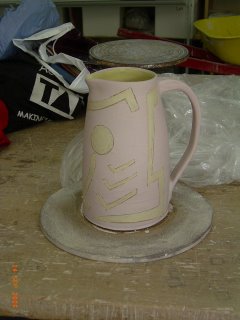
Cubism - Anne Dangar
I looked at Cubism in my previous module - Art History 1750 to 1920.This time I am looking more at the experiences of Anne Dangar, an Australian who lived and studied in France. Here is a photo of a jug I am making which is inspired by her designs.
She took up residence at Moly-Sabata where Albert Gleizes ran an artists' cooperative, so that she could study his theories. She had to support herself and so learned pottery which she decorated in the Abstract Cubist style to sell. She also taught art to the local village children. In 1939 she was invited to Fez (Morocco) by the French government to teach the local potters who were loosing their skills. She gave lessons in design attuned to their own heritage.Dangar wrote continuously to Grace Crowley in Sydney throughout her years of exile. She wrote explaining Gleizes theories and encouraged Crowley to embrace them in her own work. Dangar never returned to Australia. A late starter as a potter, she devoted her life to her art.
Reference:
Book: Earth, Fire, Water, Air Anne Dangar's Letters to Grace Crowley 1930-1953)
Web: http://www.nga.gov.au/dangar/index.cfm
